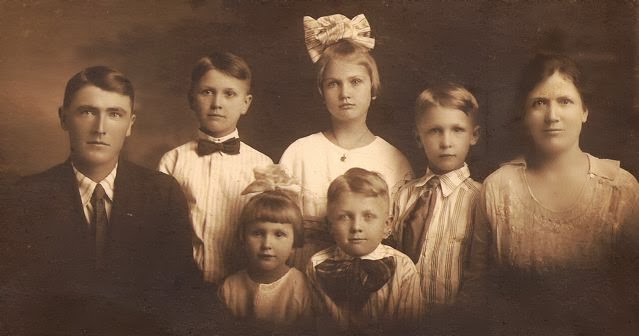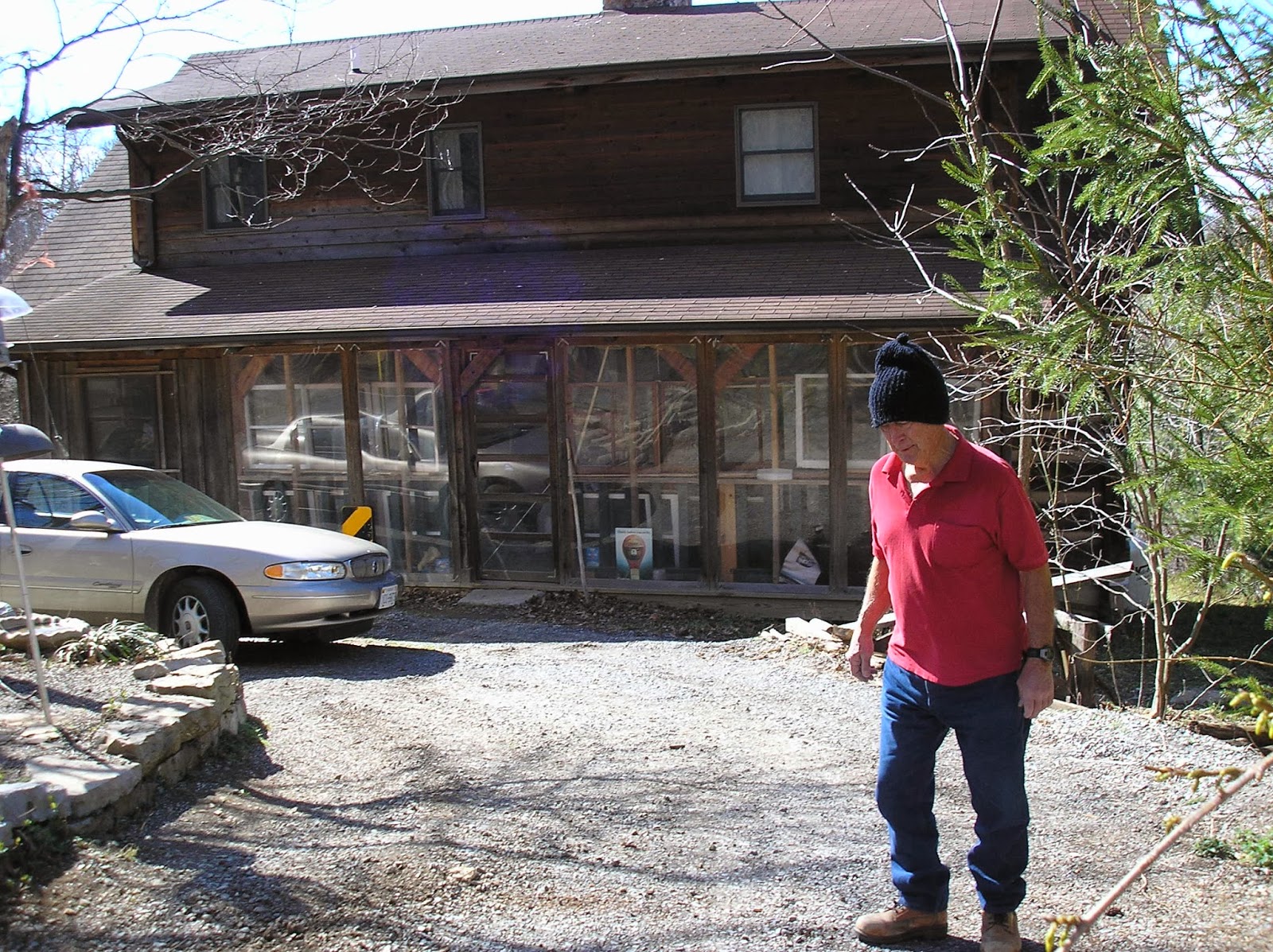Several years ago, I became interested in the Adam Harman story when I learned that I was descended from him and that he was actually a character in a book I had read several years earlier, Follow the River, by James Alexander Thom. My curiosity resulted in researching the story of Adam Harman to write an article for the Smithfield Review. Part of the fun of it has been that I have met or been contacted by a number of Harman descendants; we are legion. Over the next several weeks, I'll be reprinting the story I wrote for the Smithfield Review. For clarification, this is a quick run-down on how my first cousins, siblings and I are descended from Adam Harman:
Heinrich Adam Hermann
|
Henry Harman
|
Mathias Harman
|
Henry Harman
|
Anna F. Harman
(married Jacob Waggoner)
|
Eli Waggoner
|
Mary Waggoner
(married Clint Troutman)
|
Verne Troutman
|
Zola Troutman
(married Myron Noble)
Article from the Smithfield Review (not all photos included here were in original article):
Along the New River near Eggleston, Virginia,
limestone palisades, jagged and forbidding, jut skyward from the river’s edge
as high as 250 feet. Below the cliffs, the river plunges to an approximate
depth of 100 feet leaving the surface smooth and sparkling in the sunshine on a
bluebird day. In the early 1700s, the area was thickly forested with oak,
chestnut, poplar, pine, and many other trees. The majesty of the landscape must have
been breathtaking to the early settlers. Or its ruggedness may have been daunting.
Despite dangers from bears, cougars, wolves, and
other wild animals, not to mention threats from the indigenous people who
resented encroachment on their lands, many immigrants ventured into the area as
soon as the territory opened up to them with the signing of the Treaty of
Lancaster in 1744. The treaty called for the Iroquois to relinquish claim to
land lying between the Alleghenies and the Ohio and for colonists to extend the
Great Road southwestward from Staunton to the New River. Many of the earliest
settlers to migrate into this region were German immigrants: farmers, furniture
makers, metalworkers, basket makers, potters, stonemasons, gunsmiths, and
fraktur artists.1 Along with
the area’s acclaimed Scots-Irish settlers, the Germans left their mark on the
culture. One of the earliest of these German settlers was Heinrich Adam
Herrmann, cited in early records as Adam Harman (also spelled Harmon, Herman,
or Hermann).2
 |
| A March 2006 view of the New River from the cliffs that Mary Ingles crossed in 1755. |
Adam
Harman sometimes played a leading role but more often a supporting role in much
of the drama of that time and place, including the Mary Draper Ingles saga. His
role in that particular event was fictionalized by James Alexander Thom in his
best selling historical novel, Follow the
River.3
Several earlier accounts of the story have been recorded, from which Thom drew
information, including one by Mary’s son John Ingles, Sr., called Escape from Indian Captivity written in
1836 and preserved unpublished by his family until 1934. Ingles describes his
mother’s meeting with Harman near the end of her ordeal:
It so
happened that a man of the name of Adam Harmon and two of his Sones was at a
place on New River where they had settled and raised some corn that summer
securing their corn and Hunting. When my mother got to the improvement not seeing
aney Howse began to Hollow Harmon on hearing the voice of a woman was a good
deal alarmed on listening being an old neighbour of my mother and well
acquainted with her voice said to his sones it certainly was Mary Ingles voice
& knowing that she was taken prisoner by the Indians was cautious there
might be Indians with her him and
his sons Caught up their guns and run on to where my mother was & you may
expect it was a Joyfull meating especialey to my mother.4
 |
| Remainder of benches for Jim Connell's outdoor drama about Adam Harman's rescue of Mary Ingles. |
Later, John P. Hale, a descendant of Mary Ingles,
elaborated on John Ingles’ account in Trans-Allegheny Pioneers, first published in 1886.5
As Mary Ingles descended from the cliffs, she came upon grounds that showed
signs of human habitation:
She saw no one, but
there were evident signs of persons about. She hallooed;
at first there was no
response, but relief was near at hand. . . .
She had been heard by Adam Harmon and his two sons, whose
patch it was, and who were in it gathering their corn.
Mrs. Ingles hallooed again. They came out of the corn and
towards her, cautiously, rifles in hand. When near enough to distinguish the
voice—Mrs. Ingles still hallooing, Adam Harmon remarked to his sons: “Surely,
that must be Mrs. Ingles’ voice.” Just then she, too recognized Harmon, when
she was overwhelmed with emotions of joy and relief—poor, overtaxed nature gave
way, and she swooned and fell, insensible, to the ground.
They picked her up tenderly and conveyed her to their
little cabin, near at hand, where there was protection from the storm, a
rousing fire and substantial comfort.6
Both John Ingles and Hale describe the
following days as Mary Ingles regained her strength under the care of the
Harman men who then took her to Dunkard Bottom where many of the settlers had
gathered together in a fort. Later in his narrative, Hale adds, “I regret that
I do not know the after-history of Adam Harmon and sons, the pioneer settlers
of this beautiful place; but from every descendant of Mrs. Ingles, now and
forever, I bespeak proper appreciation and grateful remembrance of the brave,
tender-hearted, sympathetic, noble Adam Harmon.”7
Although Hale knew nothing about Adam Harman and
his “after-history,” the story of Harman and his two sons, presumed by the
Harman family to be the two oldest, Adam Jr. and Henry,8
has been preserved in historical records and by their many descendants. Adam
Harman’s contribution to the settling of Southwest Virginia precedes and goes
beyond the tale of Mary Draper Ingles.
1 “Southwest
Virginia’s German Heritage on Exhibit at Ferrum College.” Ferrum News. 06 June 2001. Accessed 02 July 2007
<http://www.ferrum.ed/news/ArchivePreMay02/germanarts.html>. According to
this web site, Fraktur is defined as “hand drawn and watercolored documents
created on the occasion of births, baptisms, marriages, and deaths.”
2 The
original German spelling of the name Harman was Hermann, but spelling of the
name was anglicized
in America. Hale spells it Harmon, with an “o” in the
second syllable, but many descendants of Adam Harman
spell the name with an “a” in the last syllable. See
John Newton Harman, Sr., Harman Genealogy (Southern Branch) with
Biographical Sketches and Historical Notes, 1700-1924, (Radford, Va.:
Commonwealth Press, Inc., 1925, reprinted 1983), 11. I will use the Harman
spelling unless quoting from a source that uses a different spelling. See also
David E. Johnston. A History of Middle
New River Settlements and Contiguous Territory, (Huntington, WV: Standard
Printing and Publishing Co., 1906), 33.
3 James
Alexander Thom, Follow the River,
(New York: Ballantine Books, 1981), 358.
4 John
Ingles, Sr. Escape from Indian Captivity:
The Story of Mary Draper Ingles and son Thomas Ingles.
2nd edition. Edited by Roberta Ingles Steele
and Andrews Lewis Ingles. (Radford, Va.: no publisher, 1982), 16.
5 Although the
accuracy of Hale’s work is in question, his comment about the “after-history of
Adam
Harmon and sones” quoted herein segues into the rest of
Adam Harman’s story.
6 John P.
Hale, Trans-Allegheny Pioneers. 3rd ed. Ed. Harold J. Dudley,
(Radford, Va.: Roberta Ingles Steele,
1971, first published 1886), 82.
7 Ibid., 67.
8 Harman
Family Bible, stored at Virginia Historical Society, The Center for Virginia
History, P.O. Box
7311, Richmond, VA 23221-0311. Copies of these records
are in the author’s possession. Also John Newton Harman, Sr., 50.
(c) 2014, Z. T.Noble






















